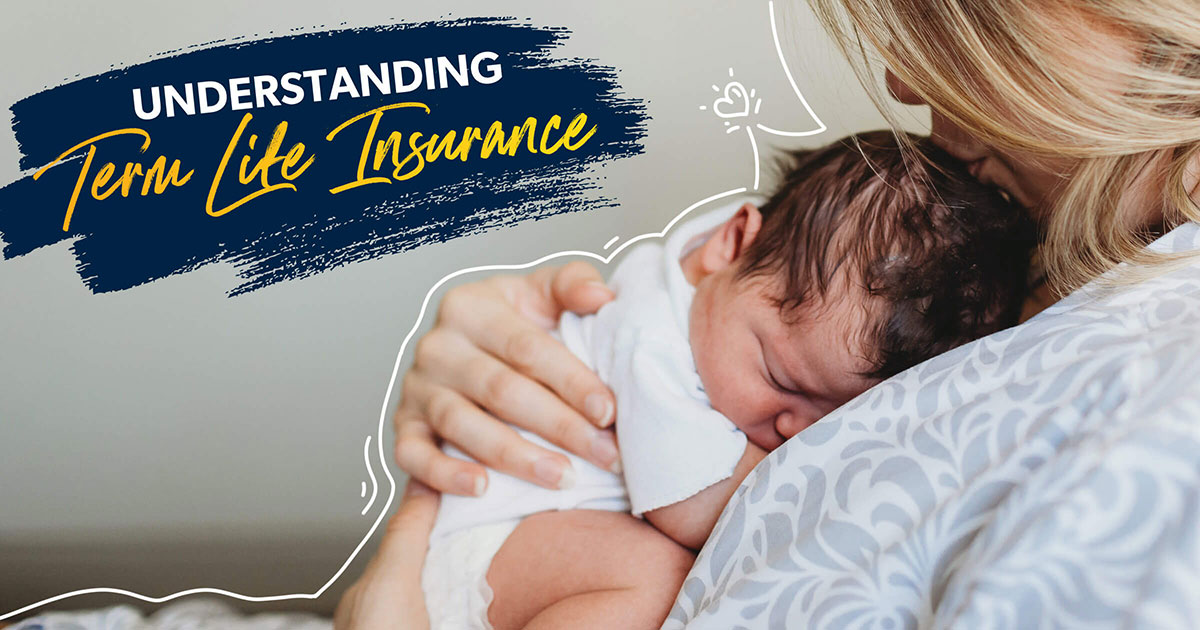
You’re not alone if thinking about life insurance doesn’t fall high on your list of fun things to do. But part of the “fun” of being an adult means handling business every day, right? Right! And besides, once you know a few basic things about how life insurance works and how much it costs, you’re well on your way to giving your family the peace of mind and protection they deserve.
What Is Life Insurance?
A life insurance policy is a financial safety net for the ones you love. And even though it isn’t the most cheerful thing to think about, buying a life insurance policy is one of the most loving and helpful things you can do for your family.
Plain and simple: The main purpose of insurance is to transfer risk. You insure your car, your health, maybe even your cell phone (but we don’t recommend that!), so that in the event of an accident, illness or some other unexpected circumstance, you’re not left footing the entire bill. It’s a similar idea with life insurance, only instead of the policy benefiting you, it benefits your loved ones.
When you buy a life insurance policy, you’re entering into an agreement with your insurance provider that, in exchange for your payments (these are called premiums), your insurer will pay your loved ones a sum of money when you die. Essentially, you’re transferring the financial hardship your death could have on your loved ones to your insurance provider instead of leaving it to your family.
But what kind of policy should you choose and just how much is all this going to cost? Don’t worry, we’ll walk you through your options so you can understand the cost of life insurance and choose the right policy for your needs.
Monthly Estimate
0 - 0
Term Life vs. Whole Life
The only type of life insurance we ever recommend is term life insurance. That’s it. No whole life, no universal life, no variable this or variable that—just term life.
Compare Term Life Insurance Quotes
And the name says it all. Term life covers a term of your life, or a period of time. Because, ultimately, you’re on your way to becoming self-insured and you don’t need a policy that lasts a lifetime. Whole life insurance (aka term life’s arch nemesis) covers your whole life. Make sense?
Another difference is that with a whole life policy, part of your premium goes into investments. The problem is that they’re bad investments. In fact, we never recommend whole life insurance because it’s such a terrible use of your money!
You’ll pay a higher premium for less coverage with a whole life policy. Since you’re paying more up front, you’re also missing a killer opportunity to invest. The whole life “investment” grows super slowly—think sloth speed, then cut that in half. That could mean hundreds of thousands of dollars in missed investment income.
A term life policy has lower premiums that save you money up front and free up more money for real investments. Let’s say you pay $20 a month for term life instead of $200 a month for a lousy whole life policy. You can take your extra $180 a month, invest it in mutual funds with good returns and watch that money grow more than that whole life policy ever would. (Again, we’re talking hundreds of thousands of dollars here!)
So skip all the whole life sales pitches and choose a term life policy instead. We recommend buying a policy that lasts 15–20 years. And your policy should cover 10–12 times your annual income. For example, if you make $50,000 a year, then you want to get a term life policy with at least $500,000 in coverage. To get an idea of how much coverage you need, check out our term life calculator.
A term life policy is meant to protect your loved ones in the event of your death during the period of your policy’s coverage. You want them to be able to cover funeral expenses, the mortgage, debt you may still be working to pay off, plus the everyday expenses of living.
And if the unthinkable does happen, your family can invest your term life insurance payout into the same types of mutual funds we just talked about. Then they can live comfortably on the return of that investment—without ever having to touch the original payout.
Of course, if you invest your money well, you’ll be able to let the term life policy expire without renewing it. Remember, the long-term goal is to become self-insured by following the 7 Baby Steps with your money. Then when your term life policy expires not only will you be debt-free with a fully loaded 3–6 month emergency fund, but you’ll also have invested in solid mutual funds that financially protect your family.
Interested in learning more about life insurance?
Sign up to receive helpful guidance and tools.
A Breakdown of the Cost of Life Insurance
Buying life insurance isn’t like buying a gallon of milk. There isn’t a set price and there aren’t any sales! There are a handful of factors that affect how much you’ll pay for coverage. In general, insurers are looking at your age, sex and health status. They’ll want to know things like your weight, the type of work you do, whether or not you smoke, and your family’s medical history. Don’t forget, they want to offload risk as much as you.
Plus, the length of your policy and how much coverage you need will also affect the cost of your life insurance. Let’s use Sarah as an example. Sarah is 30 years old, healthy, a nonsmoker and makes $50,000 a year. She’s married with a two-year-old daughter. Other than $100,000 left on their mortgage, she and her husband are debt-free.
Since we recommend securing 10–12 times your annual income, Sarah needs at least a $500,000 policy. And because her kiddo is still very young and their home isn’t paid off, Sarah is looking at a 20-year policy. That protects the family long enough for her daughter to reach college-age and to help with the mortgage in the event of her death before the policy expires. Here’s how all that starts to break down!
The Cost of Term Life Insurance by Age
One of the biggest factors in determining the cost of your term life insurance is age. You can expect a lower monthly or annual premium the younger you are. This is because rates go up as life expectancy goes down.
Here’s how Sarah’s 20-year policy for $500,000 of coverage would change based on how old she is when she opens the policy and her smoking status. (More on smoking in just a second!) As you can see, premiums go up and up the older you get. So no matter what Baby Step you’re on—or if you’re not even sure what the Baby Steps are—lock in your term life insurance coverage now!
The Cost of Term Life Insurance by Gender
Another factor that determines your premium is gender. In general, women outlive men. So men may pay upwards of 25% more for their term life premiums than women. In the eyes of an insurer, men’s shorter lifespans pose a bigger risk of the insurance company having to pay out on the policy. You can see below how Sarah’s $500,000 policy compares to the same policy purchased by a man.
The Cost of Term Life Insurance by Health Factors
OK, so reason #1,275,684 why good health is so important: It means a lower premium on your term life insurance! Insurance companies will look at a variety of health factors to determine your policy’s rate. Some insurers may not require a medical exam. Others might require an in-person exam or a phone interview to review your personal and family health history. Once the insurance company gathers all your information, you’ll be assigned to a rate class. Your rate class, ranging from Preferred Plus (lowest risk) to Standard (highest risk), sets your premium.
One of the biggest health risk factors every insurer is going to look at is tobacco use. Smoking, vaping, chewing tobacco, any tobacco of any kind—it all counts against you and will make your term life rates go up. Insurance companies are also going to look at your weight, your blood pressure, past or current medical issues, your family’s health history and even what you do for a living. (A math teacher is a much safer bet than a stunt double!) Check out how Sarah’s rate would change if her health risk factors went up and her rate class changed.
The Cost of Term Life Insurance by Policy Length
The length of your term life insurance policy also affects your premium. The most popular policy length is 20 years. But you can find policies ranging from 10–30 years. Generally speaking, the shorter the length of the policy, the cheaper the rate.
Remember, a term life policy is meant to relieve financial burden caused by death. Your policy isn’t meant to make anyone rich, but to help make sure debts are still paid, funeral expenses are covered and quality of life is maintained. In most cases, a 15–20-year policy is best. For younger families especially, that provides enough years of coverage to get children to college-age, plus the house and all other debts paid off.
Here’s how Sarah’s rates would change based on a 10-year vs. 20-year policy.
The Cost of Term Life Insurance by Location
In general, where you live has a small effect on how much you’ll pay for term life insurance. But it doesn’t have anything to do with whether you live in an earthquake zone or an area with frequent tornados. It mostly has to do with the insurance policies and regulations your state has put in place. Should your insurance company go broke or out of business, each state has organizations in place to make sure your claims would still be paid. Premiums in some areas may be higher than others so there’s always enough money in the pot for everyone.
Get Term Life Insurance Rates from Zander Today!
RamseyTrusted partner Zander Insurance will get you rates from top life insurance companies and pair you with the one that fits you best.
The Best Term Life Insurance Policy for You
Life insurance is a major part of a healthy financial plan. Don’t go another day without a term life insurance policy in place. And when it comes to insuring your family’s future, don’t pick just any ol’ company. Our trusted friends at Zander Insurance have been helping people find the best policy to protect their family for more than 50 years. With their help, you can be sure you’re getting the right life insurance for you and your loved ones.


